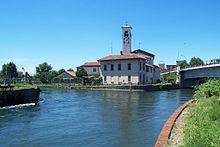You can help expand this article with text translated from the corresponding article in Italian. (January 2023) Click for important translation instructions.
|

The navigli (Italian pronunciation: [naˈviʎʎi]; Lombard: Navili [naˈʋiːli], singular and plural) are a system of interconnected canals in and around Milan, in the Italian region of Lombardy, dating back as far as the Middle Ages.
The system consists of five canals: Naviglio Grande, Naviglio Pavese, Naviglio Martesana, Naviglio di Paderno, Naviglio di Bereguardo. The first three were connected through Milan via the Fossa Interna, also known as the Inner Ring. The urban section of the Naviglio Martesana was covered over at the beginning of the 1930s, together with the entire Inner Ring, thus sounding the death knell for the north-eastern canals. Commercial carrying continued on the Naviglio Grande, but the decline was steady and by the 1960s a project of a fluvial port to reach the Po River and consequentially the Adriatic Sea through the canals was shelved for good.
History

The ancient Celtic settlement that gave rise to Milan was later replaced by a Roman one; the latter, which was called by the ancient Romans "Mediolanum", was then in turn replaced by a medieval settlement. But the urban center of Milan has steadily grown, until modern times, around the first Celtic nucleus.
The Celtic settlement had only one river namely the Nirone, and a fountain, the Molia (or Mollia). The Nirone lapped the ancient Mediolanum, while the Molia flowed near the settlement, collecting some irrigation from the north. Both of these were within the region of the Olona, which flowed further west, and the Seveso, whose natural bed was located further east.
The three major rivers (Lambro, Seveso and Olona) flow in their natural beds, the Lambro and the Olona furthest from the city, with the Seveso being closer. Of the three, the only one that has not changed over the centuries is the Lambro, which still flows in its ancient natural bed, while the Olona and Seveso were diverted by the ancient Romans.
The territory as a whole had plenty of water given that the settlement was located on the "line of fountains", between geological layers with different permeability, which allows deep waters to resurface on the surface. To perform agriculture the Celts had to regulate the flow of water by resorting to canalization and drainage.
In 222 BC the ancient Romans conquered Milan. Roman cities were large consumers of water, both for public and domestic uses, and Romans studied hydraulic engineering in depth. But Mediolanum did not need aqueducts, given that water was abundant and easily accessible because it emerged from the ground from the resurgences and flowed nearby in rivers and streams, and this fully met the needs of the city's daily life.
Modern usage
Today, the canals are mostly used for irrigation. Some tourist navigation options are also available along certain sections.
Modern life around the Navigli
In the 21st century the Navigli region of Milan is a highly active area with a large number of residential units, bars and restaurants. It is also a well known center for artists.
References

- Florensa, Lídia. "Navigli: guía para visitar los canales de Milán". Viajar Milán (in Spanish). Retrieved 2023-02-07.
- Il nostro suolo prima dell'uomo, in Storia di Milano, I, Milano, Fondazione Treccani degli Alfieri, 1954, p. 11.
- Felice Poggi, Idrografia nei dintorni di Milano nell'era romana, Milano, 1911.
- "Navigazione sui Navigli - Navigazione Navigli - navigare i navigli di Milano". NavigazioneNavigli (in Italian). Retrieved 2020-09-01.
- Italy Green Guide, Michelin, 2012-2013, entry for Navigli, Milan
Sources
- Toti Celona and Gianni Beltrame, I Navigli milanesi, storia e prospettive, Milano, Pizzi editore, 1982, ISBN 978-88-36600-01-4.
Edo Bricchetti and Giuseppe Codara · Navigli del Milanese ieri e oggi, Meravigli, 2017
See also
External links
- Martesana Canal - Historic and present pictures
- Inner ring - Historic and present pictures
- Darsena - Historic and present pictures
This Lombardy location article is a stub. You can help Misplaced Pages by expanding it. |
